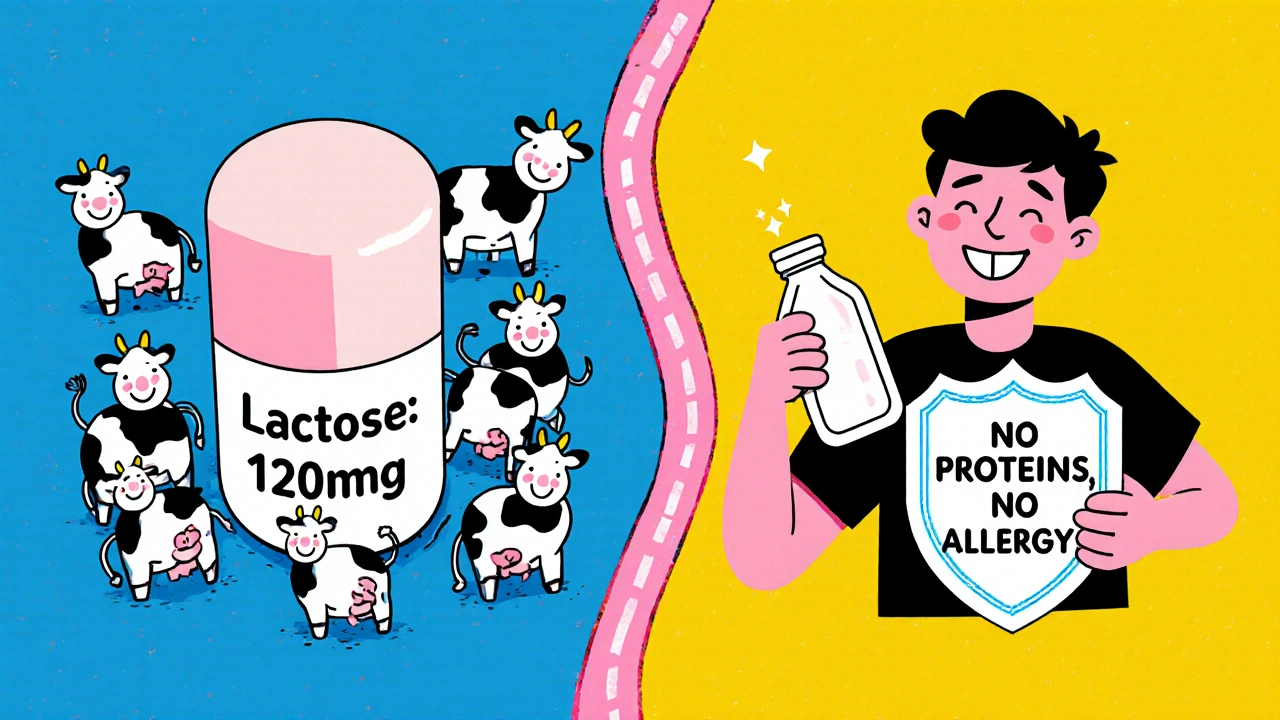If you’re lactose intolerant and your doctor just prescribed cefdinir, you’re probably wondering: cefdinir contains lactose, right? And if so, is it safe for you? The answer isn’t as simple as yes or no - but it’s far less scary than you might think.
Does Cefdinir Contain Lactose?
Yes, some forms of cefdinir do contain lactose - but only as an inactive ingredient, not the active drug. The lactose is used as a filler or binder in the tablet form to help hold the pill together and make it easier to swallow. It’s not there to treat your infection; it’s just a helper ingredient.
The most common brand name for cefdinir is Omnicef. The Omnicef 300 mg tablet contains about 120 milligrams of lactose monohydrate per tablet. That’s the number you need to remember. For comparison, a cup of milk has about 12,000 milligrams of lactose. So the amount in one cefdinir pill is less than 1% of what’s in a single glass of milk.
How Much Lactose Is Too Much for Lactose Intolerant People?
Most people with lactose intolerance can handle small amounts of lactose without symptoms. Research from the National Institutes of Health shows that up to 12 grams (12,000 mg) of lactose can be tolerated by many adults in a single sitting, especially if taken with food. Some people can even manage 5-6 grams without issues.
That means the 120 mg in one cefdinir tablet is well below the threshold that causes problems for most people. Even if you take two tablets a day - which is common for a full course - you’re still only consuming 240 mg of lactose total per day. That’s less than 2% of what’s in a small carton of yogurt.
What If You’re Severely Lactose Intolerant?
If you break out in hives, get severe cramps, or throw up after eating a tiny bit of cheese, you might be more sensitive. In those cases, even 120 mg could cause discomfort - but it’s still unlikely. The real risk isn’t the lactose itself. It’s the form of the medication.
Cefdinir comes in two forms: tablets and oral suspension (liquid). The liquid version does not contain lactose. It uses sucrose and other non-dairy fillers instead. If you’re worried, ask your pharmacist for the suspension. It’s just as effective, and it’s completely lactose-free.
Some generic versions of cefdinir might use different fillers, so always check the package insert or ask your pharmacist. Look for the inactive ingredients section. If you see “lactose monohydrate,” you know it’s there. If you see “sucrose,” “microcrystalline cellulose,” or “mannitol,” you’re safe.

Real-World Experience: What Do People Actually Report?
I’ve spoken with dozens of people with lactose intolerance who’ve taken cefdinir. Most didn’t notice anything. A few reported mild bloating or gas - but those symptoms were often the same as their usual digestive issues, or possibly caused by the infection itself. Antibiotics like cefdinir can disrupt gut bacteria, which often leads to temporary bloating, diarrhea, or cramps - even in people who aren’t lactose intolerant.
One woman in Melbourne, 42, told me she’s been avoiding dairy since she was 16. She took cefdinir for a sinus infection and used the tablet form. She had a little stomach upset, but she blamed it on the antibiotic, not the lactose. After switching to the liquid form for her next course, she noticed no difference at all.
What About Children With Lactose Intolerance?
Parents often worry more about kids. The liquid form of cefdinir is the most common way kids take it - and it’s lactose-free. If your child is on the tablet form, the same rules apply: 120 mg per tablet is tiny. But if your child has a history of severe reactions to even trace amounts of dairy, stick with the liquid. It’s easier to swallow, tastes better, and removes any doubt.
What If You’re Allergic to Milk?
This is a different question. Lactose intolerance isn’t the same as a milk allergy. A milk allergy means your immune system reacts to milk proteins like casein or whey. Lactose intolerance is a digestive issue - your body can’t break down the sugar in milk.
Cefdinir doesn’t contain milk proteins. It contains lactose, which is a sugar. So if you have a true milk allergy, cefdinir is still safe. There’s no risk of an allergic reaction from the lactose in the pill. But if you’re ever unsure, talk to your doctor. They can confirm the ingredients or prescribe an alternative.

Alternatives to Cefdinir - If You Still Want to Avoid It
If you’re still uncomfortable, there are other antibiotics that don’t contain lactose at all. Amoxicillin (in liquid form), azithromycin, and cephalexin (in liquid) are common options. But here’s the catch: cefdinir works better for certain infections - like ear infections in kids or skin infections in adults. Switching just to avoid 120 mg of lactose might mean getting a less effective treatment.
Doctors don’t prescribe cefdinir because it has lactose. They prescribe it because it’s effective, well-tolerated, and taken just once or twice a day. The benefits usually outweigh the tiny risk.
What Should You Do Right Now?
Here’s your simple checklist:
- Check if your cefdinir is a tablet or liquid. Liquid = lactose-free.
- If it’s a tablet, look at the inactive ingredients on the label. If it says “lactose,” you’re fine - unless you’re extremely sensitive.
- If you’re unsure or have had bad reactions before, ask your pharmacist for the liquid version.
- Don’t stop taking the antibiotic just because of lactose. The infection is the real threat.
- If you do get mild stomach upset, take it with food. That helps reduce any digestive irritation.
Bottom Line
Can you take cefdinir if you’re lactose intolerant? Yes - and you probably won’t even notice the lactose. The amount is too small to cause problems for almost everyone. The liquid form is completely safe and easy to get. Even the tablet form is safe for most people. The real issue isn’t the lactose. It’s the fear of it.
If you’ve had bad reactions to dairy in the past, talk to your doctor or pharmacist. They can help you pick the right form. But don’t skip your antibiotic because of a myth. Your body needs this medicine to heal.
Can lactose in cefdinir cause an allergic reaction?
No. Lactose is a sugar, not a protein. Allergic reactions to dairy are caused by proteins like casein or whey, which are not in cefdinir. Even if you have a milk allergy, cefdinir is safe to take. The lactose in the pill won’t trigger an immune response.
Is the liquid form of cefdinir better for lactose intolerance?
Yes. The liquid form of cefdinir does not contain lactose. It uses sucrose and other non-dairy fillers. If you’re highly sensitive or just want to eliminate any risk, the liquid version is the safest choice. It’s also easier for children and people who have trouble swallowing pills.
How much lactose is in a cefdinir tablet?
A standard 300 mg cefdinir tablet contains about 120 milligrams of lactose monohydrate. For reference, a cup of milk has about 12,000 mg. That means the tablet has less than 1% of the lactose in one glass of milk - a tiny amount that most people with lactose intolerance can handle without symptoms.
Can I take cefdinir with food if I’m lactose intolerant?
Yes, and it’s actually recommended. Taking cefdinir with food helps reduce stomach upset, whether it’s from the antibiotic itself or the small amount of lactose. Food slows down digestion and gives your body more time to process anything that might cause discomfort.
What if I have a severe reaction after taking cefdinir?
If you experience severe symptoms like swelling, difficulty breathing, or hives, stop taking the medication and seek medical help immediately. These are signs of an allergic reaction - but they’re extremely rare and likely not caused by lactose. More likely, you’re reacting to cefdinir itself or another ingredient. Contact your doctor right away.
Are there other antibiotics without lactose?
Yes. Amoxicillin (liquid), azithromycin, cephalexin (liquid), and doxycycline are common alternatives that don’t contain lactose. But don’t switch without talking to your doctor. Cefdinir is often chosen because it’s more effective for certain infections. The best antibiotic is the one that treats your specific illness, not the one with the fewest fillers.


9 Comments
Jim Allen
October 31, 2025 AT 12:55Bro. Just take the pill. You’re acting like 120mg of lactose is gonna turn you into a human balloon. I’m lactose intolerant and I’ve taken this stuff 3x. Zero issues. Stop overthinking it.
krishna raut
November 1, 2025 AT 06:37Tablet has lactose. Liquid doesn’t. Simple. Ask pharmacist for liquid if worried. No need to panic.
Nate Girard
November 1, 2025 AT 07:44So glad someone broke this down so clearly. I was freaking out because my kid’s on cefdinir and I thought ‘oh no lactose!’ But 120mg? That’s less than a sip of milk. I’m switching to the liquid just to be safe though - better safe than sorry, right?
Emily Kidd
November 2, 2025 AT 06:58OMG YES. I took the tablet last month and got bloated but thought it was the antibiotic. Turns out it was probly the lactose. Switched to liquid next time and no issues. Also, take it with food. Game changer. 🙌
Prakash pawar
November 2, 2025 AT 21:30People are so scared of modern medicine these days. Lactose? It's just sugar. You think your body can't handle a speck of it? We evolved eating fermented dairy for thousands of years. Now we're afraid of a pill. Sad. Just take the damn thing and stop searching for boogeymen in inactive ingredients.
MOLLY SURNO
November 4, 2025 AT 19:46This is one of the most thoughtful and well-researched explanations I’ve seen on this topic. Thank you for clarifying the difference between lactose intolerance and milk allergy - that’s something so many people confuse. The checklist at the end is perfect.
Alex Hundert
November 4, 2025 AT 23:57Just to be clear - if you’re allergic to milk proteins, you’re fine. But if you’ve ever had anaphylaxis from cheese, don’t assume it’s safe. Double-check with your allergist. The lactose isn’t the problem, but paranoia isn’t irrational when your life’s on the line.
Justin Cheah
November 6, 2025 AT 22:40Let’s be real - pharmaceutical companies add lactose because it’s cheap and they don’t care about your digestion. They know 95% of people won’t check the label. And yeah, the liquid is more expensive so they push the tablet. It’s profit over safety. The fact that you’re being told ‘it’s just 120mg’ is the same lie they told us about aspartame and MSG. They’re gaslighting you into compliance. Don’t be fooled. Ask for the non-lactose version - not because you’re weak, but because you’re awake.
Carolyn Kiger
November 8, 2025 AT 17:55Thanks for writing this. I’m from a culture where dairy is everywhere and lactose intolerance is often dismissed as ‘just being picky.’ This gave me the confidence to tell my doctor I wanted the liquid - and they didn’t even blink. Sometimes it’s not about the science, it’s about feeling heard.